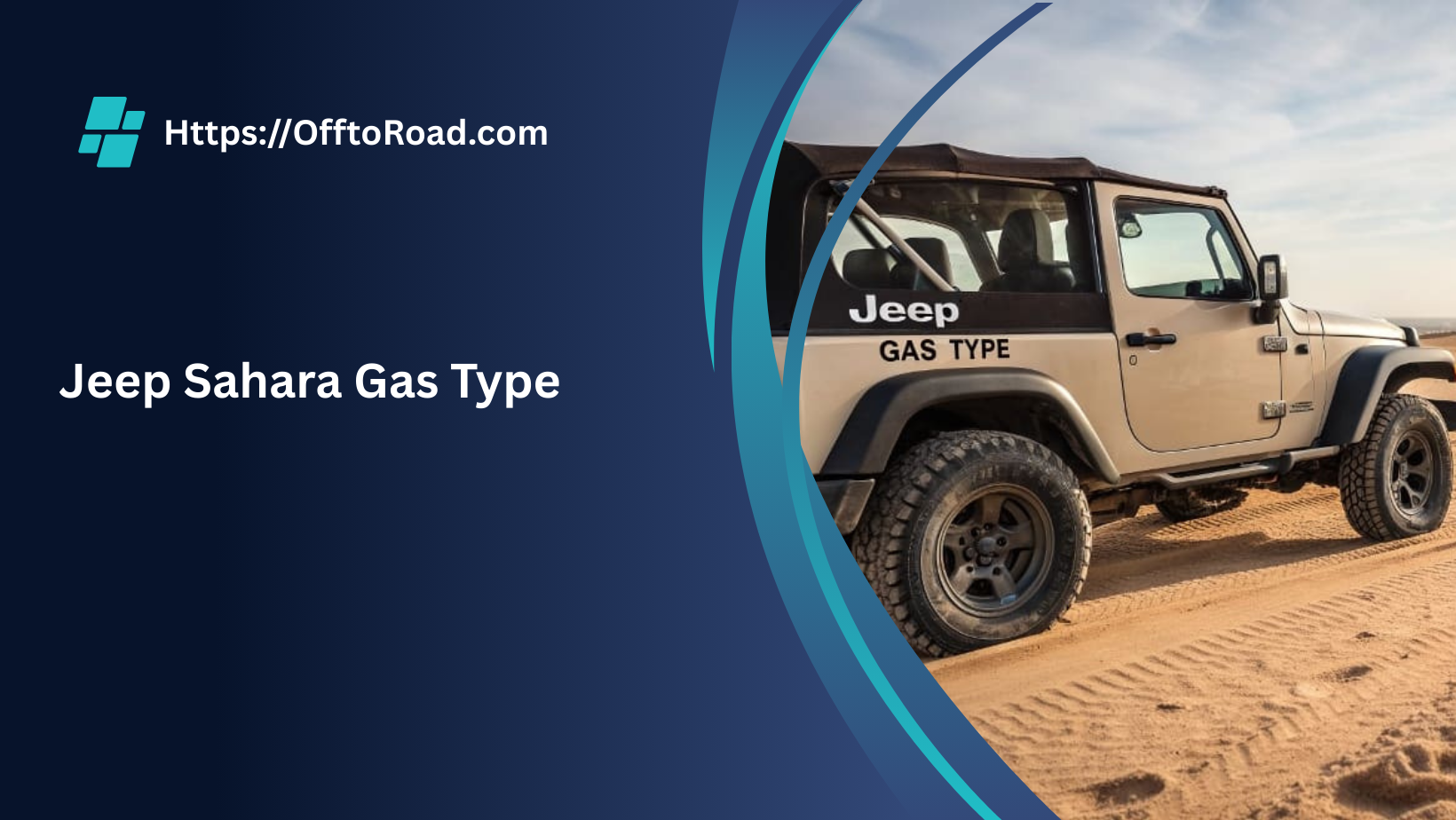For most Jeep Sahara models, regular unleaded gas (87 octane) is totally fine. But if you have the 2.0L Turbo or the 4xe hybrid, using premium gas (91 octane) could give your ride a little extra boost in performance.
In this article, we’re going to dive into the Jeep Sahara gas type and help you understand what fuel is best for your ride. Whether you’re using regular unleaded or premium gas, I’ll walk you through how the right choice can make a difference in your Jeep’s performance and efficiency—let’s get started!
What Gas Does the Jeep Sahara Need?
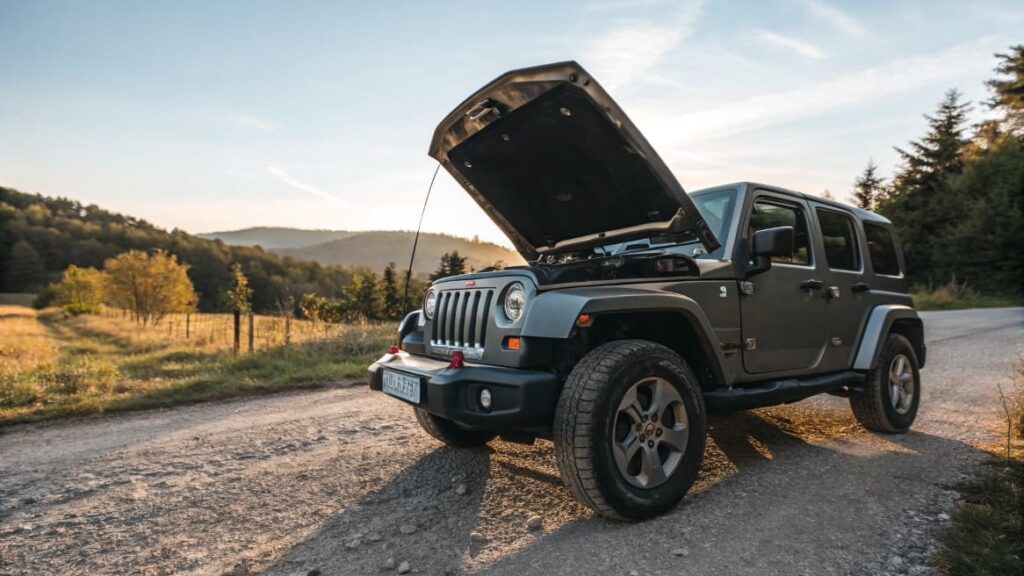
For most Jeep Sahara models, regular unleaded (87 octane) is all you need. It’s the most common and affordable option, and your Jeep will run just fine on it. But, depending on the engine and model year, there are some exceptions you should know about. Let’s look at the specifics in the table below:
| Model Year | Engine | Recommended Fuel |
| 2012–2018 | 3.6L V6 Pentastar | Regular Unleaded (87 octane) |
| 2019–2025 | 2.0L Turbo I4 | Regular Unleaded (87 octane) Premium (91) recommended |
| 2019–2025 | 3.6L V6 Pentastar | Regular Unleaded (87 octane) |
| 2020–2025 | 3.0L EcoDiesel V6 | Ultra-Low Sulfur Diesel (ULSD) |
| 2022–2025 | 2.0L Turbo I4 (4xe hybrid) | Premium Unleaded (91 octane) |
Should You Use Premium Gas?
You might be wondering, “Do I really need to use premium gas?” The answer is—it depends. For most Jeep Sahara models, regular unleaded gas works perfectly fine. But if you’ve got the 2.0L Turbo engine, you might notice a small improvement in performance by switching to premium gas, especially on longer trips. I personally tested both, and I did notice that the ride felt a little smoother with the premium. That said, it’s totally optional—your Jeep will still perform well with regular gas.
What Happens if You Use the Wrong Gas?
Okay, so let’s say you accidentally put the wrong gas in your Jeep. Don’t stress! Your Jeep will adjust, and you should be fine. However, consistently using a lower octane fuel than what your engine needs can lead to a few issues, like knocking sounds or reduced fuel efficiency. I recommend double-checking your owner’s manual or the label on the inside of the gas cap just to avoid any problems. It’s a simple step that can save you from any potential headaches down the road.
Quick Recap:
- Most Jeep Saharas: Regular Unleaded (87 octane)
- 2.0L Turbo Engine: Regular is fine, but Premium (91 octane) is recommended for a little extra boost
- EcoDiesel Engine: Ultra-Low Sulfur Diesel (ULSD) is a must
- 4xe Hybrid: Premium Unleaded (91 octane) recommended for best performance
Final Tip:
If you’re ever unsure, it’s always best to peek at your Jeep’s owner’s manual or the gas cap for confirmation. It takes just a second, and it’ll help keep your Jeep running smoothly for years to come!
Also Read: https://offtoroad.com/2020-jeep-wrangler-rubicon-gas-type/
What about the Grand Cherokee Sahara?
Great question! The Grand Cherokee Sahara is a bit different when it comes to fuel, depending on the model year and the engine it’s got under the hood. Let’s break it down so it’s easy to understand.
Gas Types for the Grand Cherokee Sahara:
| Model Year | Engine | Recommended Fuel |
| 2011–2022 | 3.6L V6 | Regular Unleaded (87 octane) |
| 2011–2021 | 5.7L V8 HEMI | Mid-Grade or Premium (89–91 octane) |
| 2014–2021 | 3.0L EcoDiesel V6 | Ultra-Low Sulfur Diesel (ULSD) |
| 2022–2025 | 2.0L Turbo I4 (4xe hybrid) | Premium Unleaded (91 octane) |
What Does This Mean?
- For most Grand Cherokee models (2011-2022): If you have the 3.6L V6, you’ll be using regular unleaded (87 octane), which is the same as the Wrangler Sahara. It’s the standard fuel, and it’s perfect for your everyday drives.
- Got the HEMI engine (5.7L V8) between 2011–2021: In this case, you’ll want to go for mid-grade (89 octane) or premium (91 octane) fuel. This ensures that your engine gets the right fuel to perform at its peak, especially if you’re planning to really test that V8 power.
- Driving the EcoDiesel model (2014-2021): For these models with the 3.0L EcoDiesel V6, you’ll need to fill up with Ultra-Low Sulfur Diesel (ULSD). This is important because regular gas or premium won’t work here, so always double-check when you’re at the pump.
- 4xe Hybrid (2022–2025): If you have the 2.0L Turbo I4 hybrid engine, Jeep recommends premium unleaded (91 octane). The hybrid system works best with this fuel, so using premium helps ensure everything runs smoothly and gives you the best performance.
What happens if you use the wrong gas?
Now, you might be wondering, “What if I mess up and use the wrong gas by accident?” Don’t worry — one wrong fill-up won’t wreck your Jeep. The engine computer adjusts, and you’ll be fine.
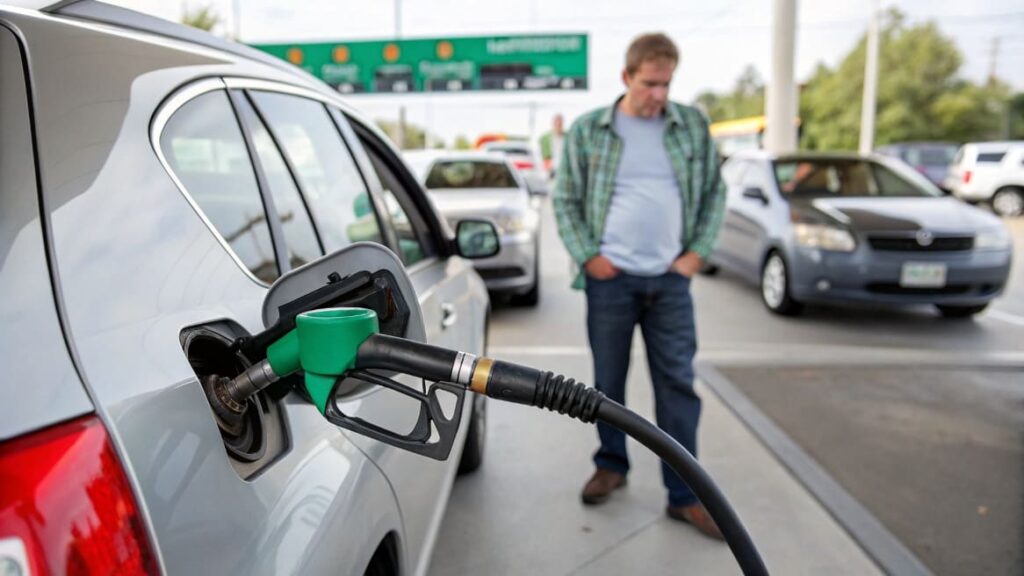
But over time, using gas that’s too low in octane for what your engine wants can cause:
- Annoying knocking or pinging sounds
- Lower gas mileage
- Slower acceleration
Personally, I always peek at the gas cap or flip through the owner’s manual when I forget. It’s a 10-second check that keeps my Jeep happy.
What kind of gas goes in a Jeep Sahara?
First things first — for most Jeep Sahara models, you’re totally fine using regular unleaded gasoline (87 octane). That’s the standard gas you’ll find at pretty much any pump. No need to spend extra on premium if you don’t have to. That’s what I use in mine most of the time, and it runs just fine.
Now, here’s where it gets interesting..
If you have one of the newer Saharas with the 2.0L Turbo engine, you can still use regular gas — but Jeep actually recommends premium (91 octane) if you want to get the best performance out of it. From my experience, when I used premium Turbo, the ride felt just a little smoother and had a tiny bit more power. So, it’s not required, but it can give you a little bonus if you’re in the mood for it.
And don’t forget — if you’re driving the 4xe plug-in hybrid model, premium gas (91 octane) is also recommended there. That’s because the hybrid system pairs best with higher octane fuel to keep things running smoothly when the gas engine kicks in.
Lastly, let’s not leave out the diesel folks. If you’ve got the 3.0L EcoDiesel engine, you’re going to need Ultra-Low Sulfur Diesel (ULSD). Just make sure to double-check the diesel pump label before you fill up — I’ve made that mistake once before and trust me, you don’t want to mix those up.
So just to make it super clear, here’s a quick rundown for you:
Most Jeep Saharas = Regular Unleaded (87 octane):
- 2.0L Turbo = Regular works, but Premium (91) recommended for best performance.
- 4xe Hybrid = Premium (91 octane) recommended.
- EcoDiesel = Ultra-Low Sulfur Diesel (ULSD).
At the end of the day, the best thing you can do is just check your owner’s manual or even peek at the gas cap — that’s what I do when I forget. It’s quick and keeps you on the safe side.
Which Jeep is best for fuel?
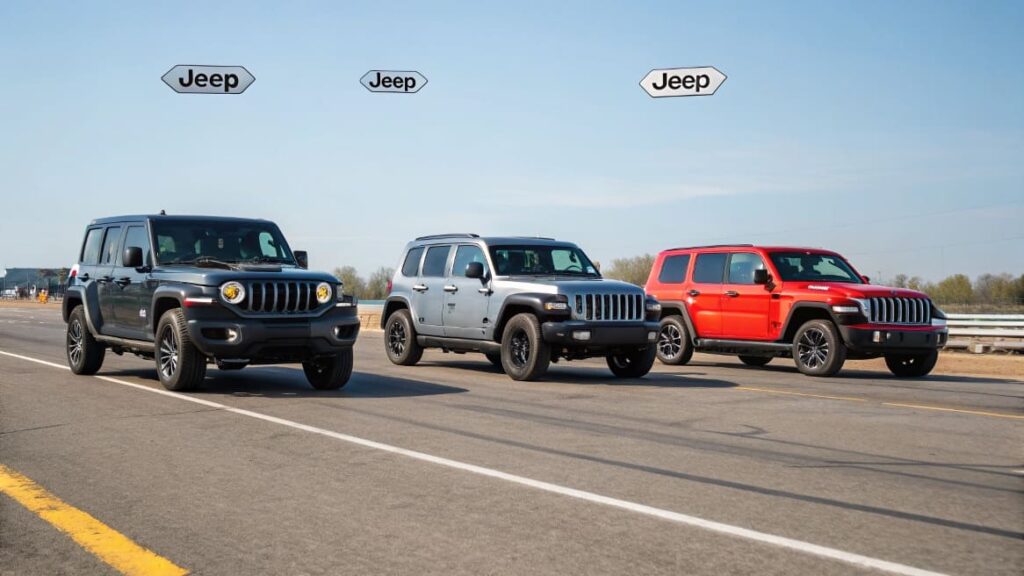
Jeep Wrangler 4xe (Plug-in Hybrid) — Best of both worlds:
If you’re like me and want a Jeep that still feels tough but doesn’t guzzle gas like crazy, the Wrangler 4xe is a sweet spot. Here’s why — it’s a plug-in hybrid, so it gives you both electric driving and a regular gas engine when you need it.
The cool part is that you can drive about 21 miles just on electric power, which means your short trips around town might not even touch your gas tank. Once the battery runs out, it smoothly switches over to gas. I’ve found that this combo makes it great for both errands and longer road trips.
- EPA rating: Around 49 MPGe (electric + gas) and 20–22 mpg when running on gas only.
Jeep Compass — Best for simple gas-only driving:
Now, maybe you’re thinking, “I don’t really want to mess with a plug-in or charging.” If that’s the case, the Jeep Compass is a smart, simple choice. It’s smaller and lighter than Jeeps like the Grand Cherokee or Wrangler, so it naturally uses less fuel.
This one’s great if you mostly stick to city driving or easy highway trips. Plus, I’ve always found it pretty comfortable and easy to park.
- EPA rating: About 25 mpg city / 32 mpg highway — nice and easy on the wallet.
Jeep Grand Cherokee 4xe — Bigger, but still fuel-friendly hybrid:
Okay, maybe you’re someone who needs a bit more space — like for family trips or camping gear. That’s where the Grand Cherokee 4xe comes in. It’s bigger than the Compass or Wrangler, but because it’s also a hybrid, it does surprisingly well on fuel.
Just like the Wrangler 4xe, you can drive short distances on electric power and switch to gas for longer hauls. Personally, if I had to haul kids, dogs, and camping gear often, this is the one I’d lean toward.
- EPA rating: About 56 MPGe (electric + gas) and 23 mpg on gas only.
Also Read: https://offtoroad.com/are-jeeps-rwd/
Here’s a quick recap — so it’s easy to remember:
- Wrangler 4xe = Best mix of off-road fun + hybrid efficiency.
- Compass = Best regular gas mileage (small SUV, easy city driver.
- Grand Cherokee 4xe = Bigger hybrid, surprisingly great MPG for its size.
Does Jeep use petrol?
Most Jeeps Use Petrol (Gasoline):
So, to start things off — the majority of Jeep models like the Wrangler, Grand Cherokee, Cherokee, Compass, and Renegade run on regular unleaded petrol (87 octane). You’ll find this fuel at almost every gas station, so it’s really easy to find and fill up. Honestly, I’ve used it plenty of times with no issues at all.
Some Jeeps Use Diesel:
But here’s the twist — a few Jeep models, like the Wrangler EcoDiesel and Grand Cherokee EcoDiesel, run on diesel instead of petrol. Diesel engines are perfect if you need more torque or if you do a lot of towing or long-distance driving. I’ve seen people love their EcoDiesels for big road trips and camping adventures, mainly because they’re more efficient for those kinds of trips.
Jeep Hybrids Use Both Petrol and Electricity:
Here’s something exciting — Jeep’s also got plug-in hybrid models like the Wrangler 4xe and Grand Cherokee 4xe. These use both electricity and petrol. For short trips, you can drive on electric power only, which is super convenient (and eco-friendly!). But when the battery runs low, the petrol engine kicks in. For these hybrids, premium petrol (91 octane) is recommended to keep everything running smoothly. I personally love the idea of going electric for errands, but knowing I have that petrol backup for longer trips.
Check Your Owner’s Manual or Gas Cap for Confirmation:
If you’re ever in doubt about what fuel your specific Jeep needs, no worries! Just take a peek at the label inside your gas cap or check the owner’s manual. It’ll tell you exactly what fuel your Jeep prefers, and you’ll never have to second-guess at the pump.
What are the three types of gas?
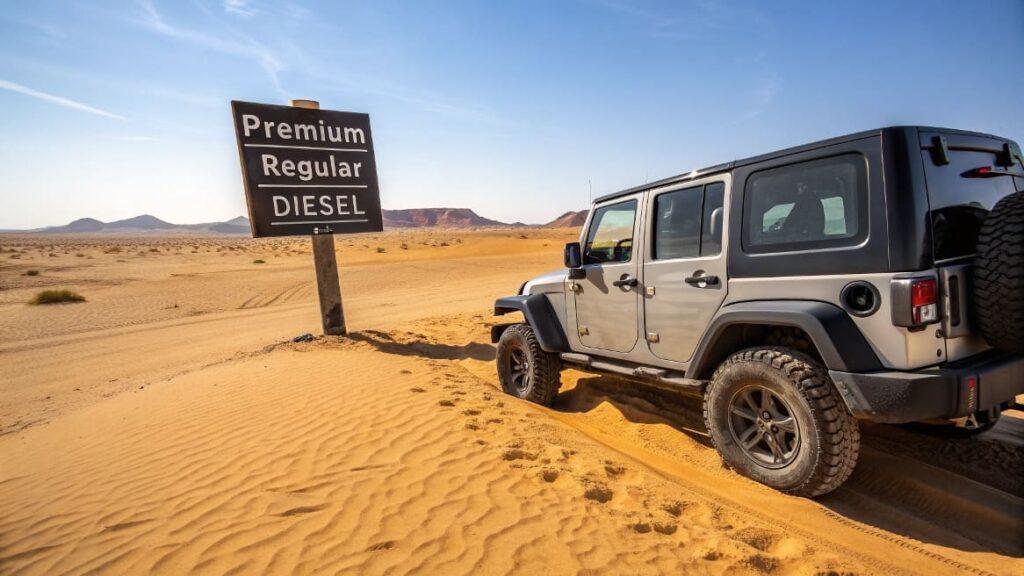
Regular Unleaded Gasoline (87 Octane):
First up, we’ve got regular unleaded gas — this is the most common type of fuel you’ll find at just about every gas station. It’s also the cheapest option. Most vehicles, especially everyday cars and trucks, run perfectly fine on regular gas. If your car doesn’t have any special performance needs, this is the one to go for. You’ll usually see it labeled as 87 octane.
Mid-Grade Gasoline (89 Octane):
Next, we have mid-grade gasoline. This one is kind of like the middle ground between regular and premium. It’s got a slightly higher octane rating (89 octane), which can be good for some cars that might need a little more oomph to run smoothly. But here’s the thing — not every car requires mid-grade, so it’s really a matter of what your car prefers. If your manual recommends it, go ahead and fill up with it!
Premium Gasoline (91-93 Octane):
And finally, we’ve got premium gasoline. This one has the highest octane rating (usually 91-93 octane), and it’s made for vehicles that have high-performance engines. If you’ve got a sports car or a luxury vehicle, this is what they usually need to run at their best. It’s more expensive, but it’s totally necessary if your engine requires it to avoid knocking or pinging.
Quick Recap:
- Regular (87 octane): Standard and most affordable, works for most cars.
- Mid-Grade (89 octane): A little higher performance, for cars that recommend it.
- Premium (91-93 octane): Best for high-performance engines, but pricier.
FAQ’s
1.Can I use mid-grade or premium gas in my Jeep Sahara?
Definitely! While regular unleaded (87 octane) is what’s usually recommended, mid-grade (89 octane) or premium (91 octane) gas can give your Jeep a bit more pep, especially if you have the 2.0L Turbo engine. It’s not necessary, but it can improve performance on longer trips.
2. What happens if I accidentally use diesel in my Jeep Sahara?
Don’t stress too much! If your Jeep Sahara isn’t a diesel model, a one-time mistake won’t wreck the engine, but it’s a good idea to correct it quickly. Just remember, next time, always double-check the pump — it’s a quick habit that could save you some trouble.
3. What fuel does the Jeep Sahara 4xe hybrid use?
For the 4xe hybrid, you’ll want to use premium unleaded (91 octane). This helps the hybrid system run as smoothly as possible, balancing both the electric and gas engine for top performance. It’s a small step for big efficiency!
4. Do I really need to use premium gas for my Jeep Sahara?
Not at all! For most daily driving, regular unleaded (87 octane) works just fine. But if you’re feeling adventurous and want a little more power, premium (91 octane) might give your 2.0L Turbo engine that extra zip for a smoother ride.
5. Is there any Jeep Sahara that uses diesel?
Yes, if you’ve got the 3.0L EcoDiesel engine, you’ll need Ultra-Low Sulfur Diesel (ULSD). Just make sure to always use the diesel pump when filling up — I’ve seen people get mixed up, and trust me, it’s not something you want to do!
Conclusion
To wrap things up, for most Jeep Sahara models, regular unleaded gas (87 octane) is perfectly fine. However, if you have the 2.0L Turbo or the 4xe hybrid, using premium gas can give your Jeep a little extra kick. So, before you fill up, it’s a good idea to double-check your Jeep’s manual or gas cap. This simple step helps keep your ride running smoothly!
